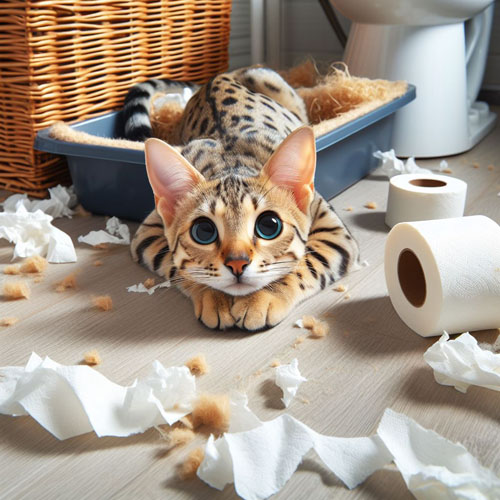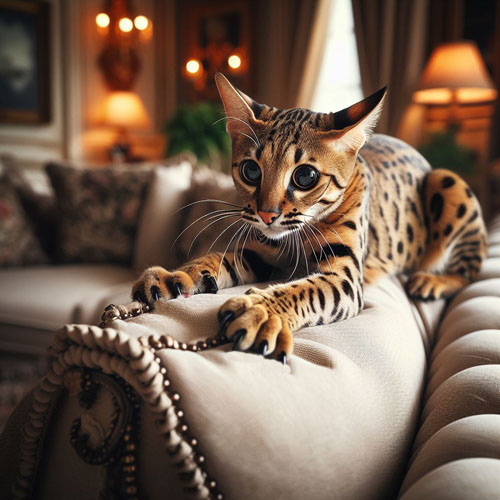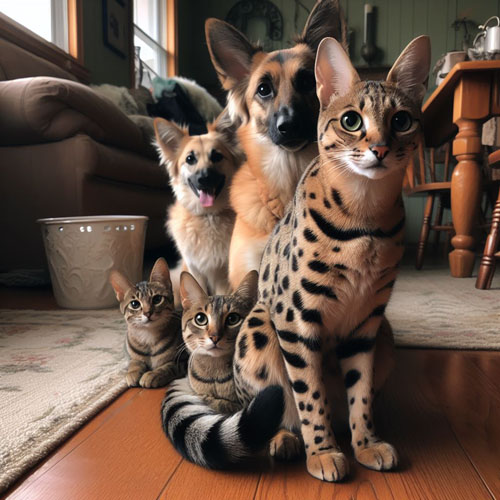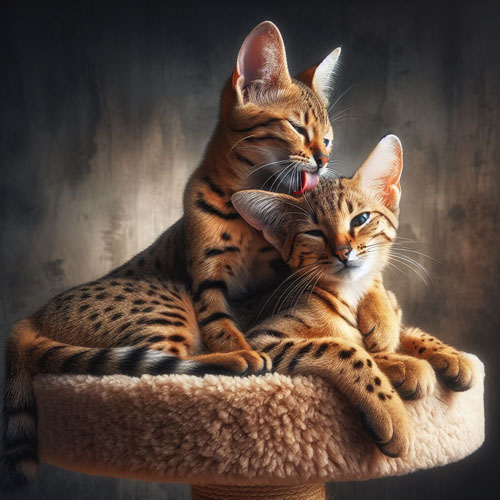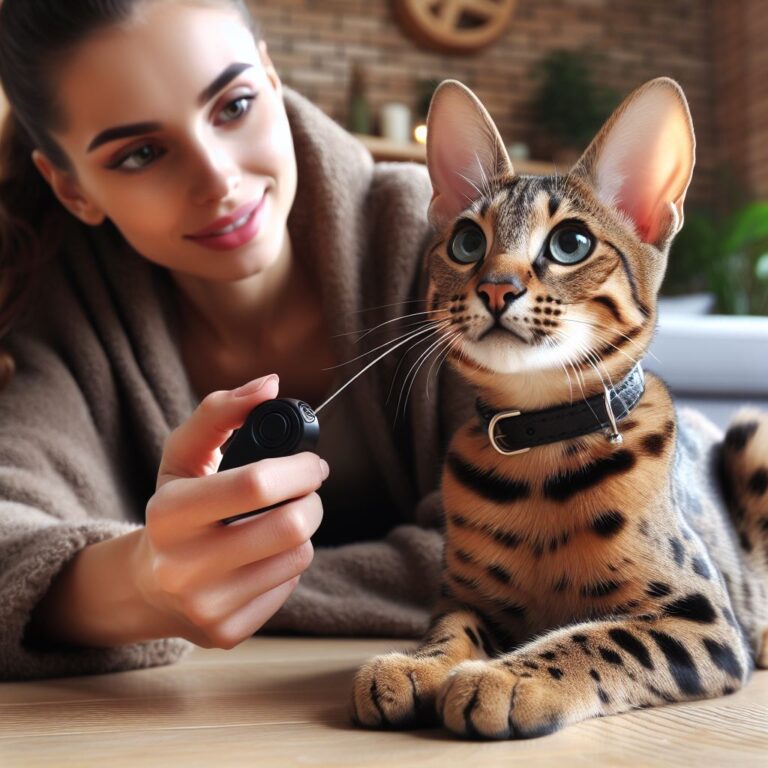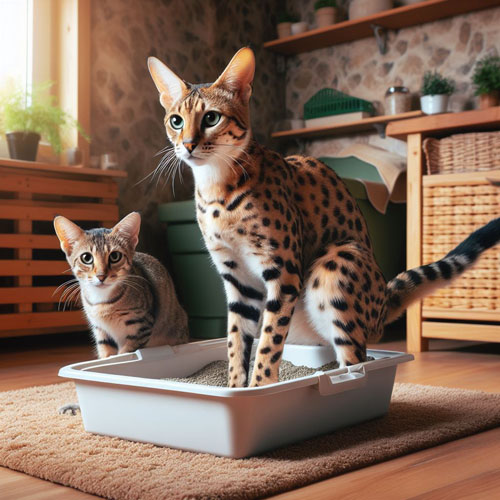Savannah Cat Body Language
Decoding the Language of the Savannah: Understanding the Communication Methods of Savannah Cats for a Deeper Human-Feline Bond
Savannah cats, with their exotic appearance and wild heritage, possess a language all their own. While they may not speak in words, their communication methods are rich and nuanced, comprising vocalizations, body language, and various forms of expression. In this comprehensive exploration, we embark on a journey to decode the intricate language of Savannah cats, delving into the significance of their cues and gestures. Understanding these communication methods is not merely a fascinating endeavor; it’s a key to forging a stronger and more meaningful relationship between humans and their feline companions.
Vocalizations: The Symphony of Savannah Speech: Savannah cats express themselves through a diverse range of vocalizations, each carrying its own unique meaning. From soft purrs to melodious chirps, these vocal cues provide valuable insights into the emotional state and intentions of these feline communicators.
- Purring: Purring is a universal language of contentment in the feline world. Savannah cats, like their domestic counterparts, purr when they feel comfortable, secure, or are in a state of bliss. However, it’s important to note that purring can also serve as a self-soothing mechanism when a cat is anxious or unwell. Understanding the context in which purring occurs is crucial for interpreting its meaning accurately.
- Chirping and Chattering: One of the distinctive vocalizations of Savannah cats is the chirping or chattering sound. This intriguing behavior often occurs when a cat is observing birds or other prey through a window. Some experts speculate that this vocalization is an expression of frustration or excitement related to their predatory instincts. The chirping serves as a way for the cat to release built-up energy and engage with their hunting instincts vicariously.
- Meowing: Meowing is a versatile form of communication for Savannah cats. Unlike some domestic cat breeds that are known for excessive meowing, Savannah cats often communicate through a range of meows, each serving a specific purpose. A short and sharp meow may signal a request for attention, while a longer and more plaintive meow could express discontent or a desire for food.
- Growling and Hissing with posturing: Growling and hissing are defensive vocalizations that signal fear, aggression, or discomfort. These sounds are often accompanied by specific body language, such as arched backs, flattened ears, and raised fur. Understanding the context in which growling or hissing occurs is crucial for responding appropriately and ensuring the safety of both the cat and those around them.
- Hissing without posturing: Servals and Savannah cats are known for their unique vocalizations, including hissing as a form of communication. Unlike some animals that hiss as a sign of aggression, these feline species often use hissing as a friendly greeting. The hissing sound serves as a means of expressing excitement or curiosity rather than a threat. This behavior is part of their social communication repertoire and helps them establish positive interactions with other cats and even humans. Observing these hissing greetings can provide valuable insights into the complex social dynamics of these fascinating wild and hybrid cat species.
- Trilling: Trilling is a gentle, melodic sound that Savannah cats often use to greet their human companions or other pets. This friendly vocalization is a sign of affection and is typically accompanied by a wagging tail and a relaxed posture.
Body Language: The Silent Symphony of Savannah Expression: While vocalizations play a significant role in Savannah cat communication, their body language is equally—if not more—expressive. Every twitch of the tail, flick of the ear, or dilation of the pupils conveys a message, providing valuable insights into the cat’s emotional state and intentions.
- Tail Language: The tail is a versatile tool for Savannah cats to communicate their feelings. A raised tail with a slight curve at the tip signals a content and confident cat. On the other hand, a puffed-up tail indicates fear or aggression, while a tucked tail may suggest submission or anxiety. Paying attention to the nuances of tail language is essential for gauging the cat’s mood.
- Ears and Whiskers: The position of a Savannah cat’s ears and whiskers also contributes to their expressive repertoire. Forward-facing ears and relaxed whiskers indicate curiosity or friendliness. Flattened ears against the head may signal fear or aggression. Understanding these subtle cues allows owners to approach their cats appropriately and create a positive interaction.
- Purring and Kneading: Beyond vocalizations, the physical behaviors of Savannah cats convey a wealth of information. Purring, as mentioned earlier, is often associated with contentment. Kneading, where a cat rhythmically presses and extends their paws against a soft surface, is a comforting behavior that originates from kitten-hood. Cats may knead when they are relaxed, happy, or seeking comfort.
- Eye Contact: Eye contact is a powerful form of communication in the feline world. Direct eye contact can be perceived as a sign of trust and affection, while prolonged staring may be interpreted as a challenge or threat. Blinking slowly at a cat is often considered a friendly gesture, signaling trust and relaxation.
- Belly Exposure: The position of a cat’s belly can be a telling indicator of their comfort level. While many people associate a cat exposing its belly with an invitation for belly rubs, this isn’t always the case. In some situations, exposing the belly is a sign of vulnerability, and attempting to touch it may result in defensive behaviors.
Other Forms of Expression: Scent Marking and Play Behavior: Beyond vocalizations and body language, Savannah cats utilize scent marking and play behavior as additional forms of expression.
- Scent Marking: Scent marking is a natural behavior for Savannah cats to establish their territory and communicate with other cats. They may rub their face against objects, people, or other animals to deposit scent from glands located on their cheeks. Understanding scent marking helps owners create an environment that respects the cat’s need for territorial expression.
- Play Behavior: Play is a crucial aspect of Savannah cat behavior, serving both as a form of physical exercise and a means of social interaction. Playful behaviors, such as chasing, pouncing, and wrestling, indicate a content and happy cat. Paying attention to their play preferences and engaging in interactive play sessions strengthens the bond between the cat and their human companions.
Enhancing the Human-Cat Relationship through Understanding: Decoding the communication methods of Savannah cats is not merely an intellectual pursuit; it is a practical tool for enhancing the human-cat relationship. By tuning in to their vocalizations, interpreting body language, and recognizing various forms of expression, owners can create an environment that fosters trust, comfort, and mutual understanding.
- Building Trust: Understanding the language of Savannah cats allows owners to build trust. Recognizing when a cat is seeking attention, expressing contentment, or signaling discomfort enables owners to respond appropriately, fostering a sense of security and trust within the human-cat relationship.
- Addressing Discomfort and Anxiety: Cats may communicate discomfort or anxiety through subtle cues. Recognizing signs of stress, such as flattened ears, dilated pupils, or defensive postures, allows owners to address the underlying causes and create a more soothing environment for their feline companions.
- Creating an Enriched Environment: By understanding a Savannah cat’s play preferences, owners can create an enriched environment that stimulates both their physical and mental well-being. Providing interactive toys, vertical spaces for climbing, and opportunities for scent exploration contributes to a happy and fulfilled cat.
- Respecting Boundaries: Recognizing a cat’s need for personal space and territorial expression is essential for respecting their boundaries. While many Savannah cats are affectionate, they may also appreciate moments of solitude. Respecting their autonomy contributes to a balanced and harmonious relationship.
- Promoting Positive Interactions: Understanding the nuances of cat communication helps owners promote positive interactions with their Savannah cats. Whether through gentle eye contact, slow blinking, or responding to their trills and chirps, owners can engage in ways that reinforce the bond and create a positive atmosphere.
Conclusion: The Art of Feline Communication
In conclusion, decoding the language of Savannah cats is an art that goes beyond spoken words. It is an intricate dance of vocalizations, body language, and various forms of expression that paints a portrait of their emotions, desires, and interactions. For owners, this art is an invitation to connect more deeply with their feline companions, bridging the gap between the domestic and the wild.
As we immerse ourselves in the symphony of Savannah speech, we gain not only insights into their individual personalities but also the keys to a more enriched and fulfilling relationship. The ability to interpret their cues allows owners to respond with sensitivity, creating an environment where trust can flourish, and the unique spirit of the Savannah cat can truly thrive.
In the ongoing dialogue between humans and their feline counterparts, understanding the language of Savannah cats is a continuous journey. It’s a journey of discovery, patience, and shared experiences that deepens the bonds between species, allowing for a companionship that transcends the boundaries of language and speaks directly to the heart. Through this shared language, we enter into a realm where the wild beauty of the savannah converges with the warmth of the domestic hearth, creating a space where the art of feline communication becomes a masterpiece of connection and understanding.
Keywords: Savannah Cat Communication, Feline Body Language, Cat Vocalizations, Human-Cat Bond, Understanding Cat Behavior
